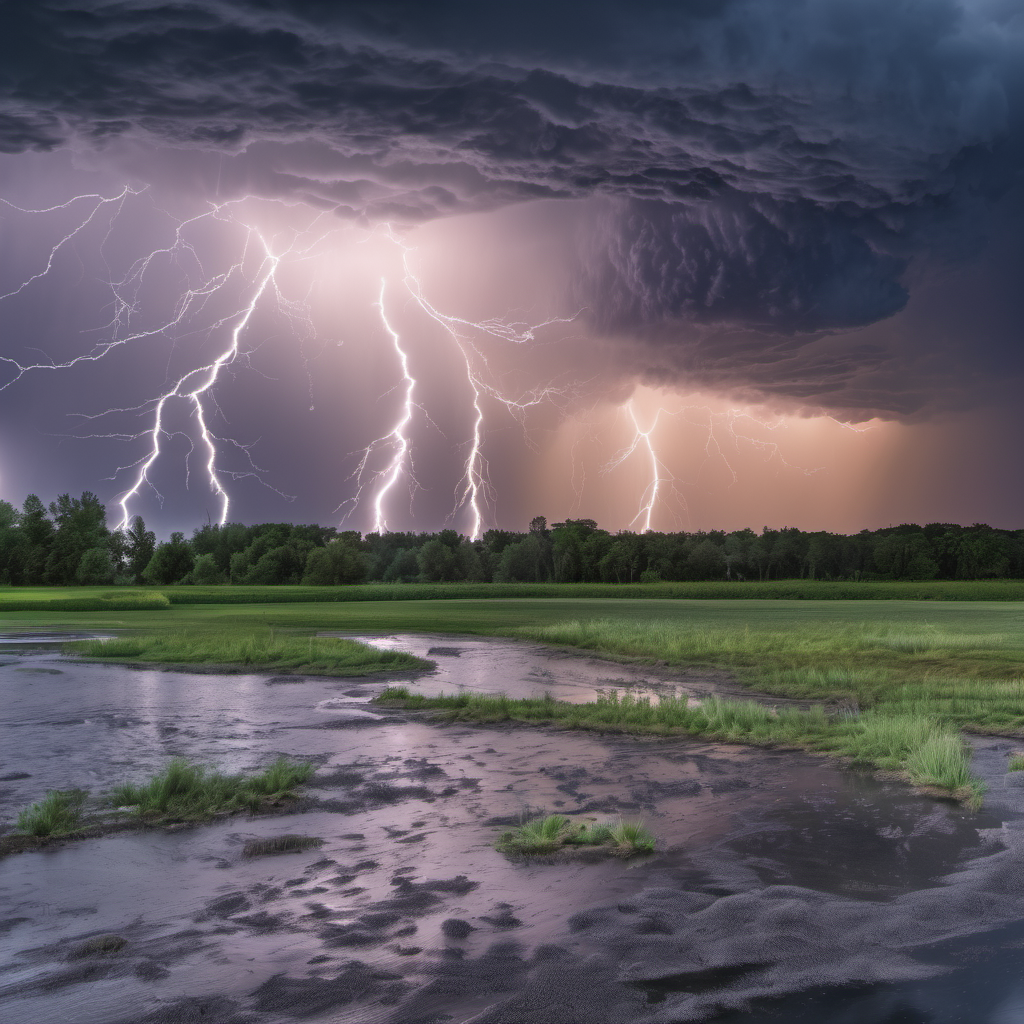
By Saeed Mirshekari
August 30, 2024


Access O'Mentors
Top Data Scientist Mentors from Fortune 500 Companies excited to help you out 1-on-1!
1️⃣ Explore freely
→
2️⃣ Apply confidently
→
3️⃣ Pay securely
→
4️⃣ Book instantly
The Statistics of Thunderstorms and the Impact of Data Analysis on Prediction and Prevention
Thunderstorms are among the most common and dynamic weather phenomena, known for their dramatic displays of lightning, thunder, heavy rainfall, and sometimes hail or tornadoes. While they can be awe-inspiring, thunderstorms also pose significant risks, including fatalities, injuries, property damage, and economic losses. Understanding the statistics of thunderstorms and leveraging data analysis for prediction and prevention are crucial for mitigating their impact.
Understanding Thunderstorms
A thunderstorm is a weather system characterized by the presence of lightning and thunder. It forms when moist, warm air rises rapidly into the atmosphere, leading to condensation and the formation of cumulonimbus clouds. Thunderstorms can vary in intensity, from mild storms bringing moderate rain to severe supercell storms capable of producing large hail, damaging winds, and tornadoes.
Frequency of Thunderstorms
Thunderstorms are a frequent occurrence globally, with certain regions experiencing them more often due to specific climatic conditions. For instance, the equatorial regions and the southeastern United States see frequent thunderstorms, with Florida known as the "lightning capital" of the United States.
- Global Perspective: Annually, there are an estimated 16 million thunderstorms worldwide, averaging about 44,000 per day.
- United States: The U.S. experiences approximately 100,000 thunderstorms each year, with around 10% classified as severe.
Seasonal and Geographic Variability
- Seasonal Variability: Thunderstorms are most common during the spring and summer months when the conditions for convective activity are most favorable.
- Geographic Variability: Areas like the central United States, known as Tornado Alley, are particularly prone to severe thunderstorms and tornadoes.
Causes of Thunderstorms
Understanding the conditions that lead to thunderstorms helps in predicting their occurrence and potential severity. Key factors include:
- Moisture: Adequate moisture in the lower to mid-troposphere is essential for cloud formation.
- Instability: Atmospheric instability, where warm air near the ground rises into cooler air aloft, is crucial for thunderstorm development.
- Lift: Mechanisms that force air to rise, such as frontal boundaries, mountains, or surface heating, initiate thunderstorms.
- Wind Shear: Changes in wind speed and direction with altitude can organize thunderstorms and enhance their severity.
Impacts of Thunderstorms
Thunderstorms can have a wide range of impacts, affecting human life, infrastructure, and the environment. These impacts can be immediate or long-term, depending on the severity and frequency of the storms.
Human Impact
Thunderstorms pose several direct and indirect risks to human life and health:
- Fatalities and Injuries: According to the National Weather Service, lightning strikes cause an average of 27 deaths annually in the United States. Additionally, severe thunderstorms can lead to injuries from hail, wind-blown debris, and tornadoes.
- Health Risks: Thunderstorms can exacerbate respiratory conditions due to changes in humidity and the dispersal of allergens.
Economic Impact
The economic consequences of thunderstorms are significant, encompassing direct damages and broader economic disruptions:
- Property Damage: Thunderstorms cause extensive damage to buildings, vehicles, and infrastructure. The Insurance Information Institute reports that severe thunderstorms caused $20 billion in insured losses in the U.S. in 2020.
- Agricultural Losses: Hail and heavy rainfall can devastate crops, leading to substantial agricultural losses.
Environmental Impact
Thunderstorms can also have mixed effects on the environment:
- Positive Effects: They play a crucial role in replenishing freshwater supplies and maintaining ecological balance.
- Negative Effects: Severe storms can cause soil erosion, deforestation, and water contamination.
Data Analysis in Thunderstorm Prediction and Prevention
Data analysis has revolutionized the way meteorologists predict thunderstorms and develop strategies to mitigate their impacts. By leveraging vast amounts of data, advanced computational methods, and machine learning algorithms, scientists can provide more accurate and timely forecasts.
Historical Data and Statistical Analysis
Historical weather data is invaluable for understanding thunderstorm patterns and trends. By analyzing past events, meteorologists can identify patterns and correlations that help predict future occurrences.
- Trend Analysis: Statistical analysis of historical data helps identify trends in thunderstorm frequency, intensity, and seasonality.
- Risk Assessment: Understanding past storm impacts allows for better risk assessment and resource allocation.
Real-Time Data Collection and Monitoring
Modern technology enables the collection of real-time data from various sources, enhancing the accuracy of thunderstorm predictions:
- Satellite Imagery: Satellites provide continuous monitoring of atmospheric conditions, helping detect the early signs of thunderstorm development.
- Radar Systems: Doppler radar systems track precipitation and wind patterns within thunderstorms, providing critical information about storm intensity and potential hazards.
- Weather Stations: Ground-based weather stations collect data on temperature, humidity, wind speed, and pressure, contributing to real-time analysis.
Predictive Modeling and Machine Learning
Predictive models and machine learning algorithms are at the forefront of modern thunderstorm forecasting. These tools analyze vast datasets to identify patterns and make predictions about thunderstorm development and progression.
- Numerical Weather Prediction (NWP): NWP models simulate atmospheric processes using mathematical equations, providing detailed forecasts of thunderstorm activity.
- Machine Learning Models: Machine learning algorithms analyze large datasets to identify patterns and improve the accuracy of thunderstorm predictions. These models can handle complex, non-linear relationships in the data, enhancing their predictive capabilities.
Early Warning Systems
Effective early warning systems are crucial for minimizing the impacts of thunderstorms. These systems use data analysis and predictive models to provide timely alerts to communities at risk.
- Alert Systems: Automated systems disseminate warnings via various channels, including mobile apps, SMS, and broadcast media.
- Public Awareness Campaigns: Educating the public about thunderstorm risks and preparedness measures enhances community resilience.
Case Study: The Tornado Warning System in the United States
The United States has developed one of the most advanced thunderstorm and tornado warning systems in the world, leveraging data analysis and technology to protect lives and property.
- Integrated Radar Networks: The National Weather Service (NWS) uses a network of Doppler radars to monitor storm development and provide real-time data on storm intensity and movement.
- Tornado Watches and Warnings: The Storm Prediction Center (SPC) issues tornado watches and warnings based on data analysis and predictive models. A tornado watch indicates that conditions are favorable for tornadoes, while a warning means that a tornado has been sighted or indicated by radar.
- Impact of Data Analysis: According to the NWS, the lead time for tornado warnings has increased from an average of 5 minutes in the 1980s to 14 minutes today, thanks to advances in data analysis and forecasting. This increase in lead time has significantly reduced the number of fatalities and injuries.
Challenges and Future Directions
While data analysis has significantly improved thunderstorm prediction and prevention, challenges remain. Addressing these challenges and advancing our capabilities will further enhance our ability to manage the impacts of thunderstorms.
Data Quality and Availability
- Data Gaps: In some regions, particularly in developing countries, there are gaps in weather data due to limited infrastructure.
- Data Quality: Ensuring the accuracy and reliability of data from various sources is crucial for effective analysis and forecasting.
Advancements in Technology
- Enhanced Observational Tools: Developing more advanced observational tools, such as high-resolution satellites and next-generation radars, will improve data collection and analysis.
- Integration of AI: Further integrating artificial intelligence and machine learning into weather forecasting will enhance predictive accuracy and provide more actionable insights.
Climate Change and Thunderstorm Activity
- Impact of Climate Change: Understanding the impact of climate change on thunderstorm frequency and intensity is crucial for future preparedness. Research suggests that a warmer climate could lead to more frequent and severe thunderstorms.
- Adaptation Strategies: Developing and implementing adaptation strategies to address the changing patterns of thunderstorm activity will be essential for mitigating future risks.
Conclusion
Thunderstorms are a pervasive and potentially destructive natural phenomenon with significant impacts on human life, the economy, and the environment. Through the power of data analysis, meteorologists can better predict and understand these storms, enabling more effective prevention and mitigation strategies. From historical data analysis to real-time monitoring and advanced predictive modeling, data-driven approaches are essential for enhancing our resilience to thunderstorms. As technology and our understanding of climatic processes continue to evolve, so too will our ability to predict, prepare for, and mitigate the impacts of these dynamic weather events.

Saeed Mirshekari
Saeed is currently a Director of Data Science in Mastercard and the Founder / Director of OFallon Labs LLC. He is a former research scholar at LIGO team (Physics Nobel Prize of 2017).